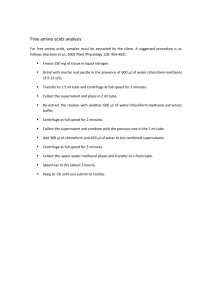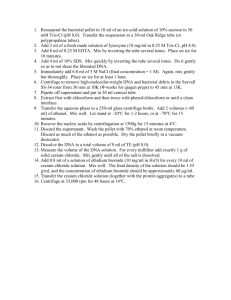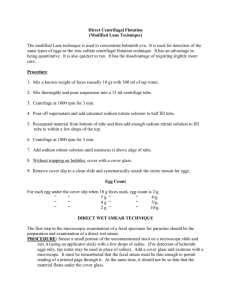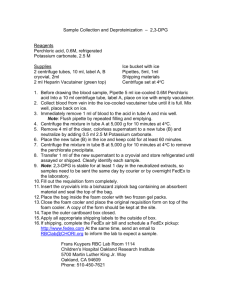Experiment 14C Extraction of Eugenol with Liquid Carbon Dioxide
advertisement
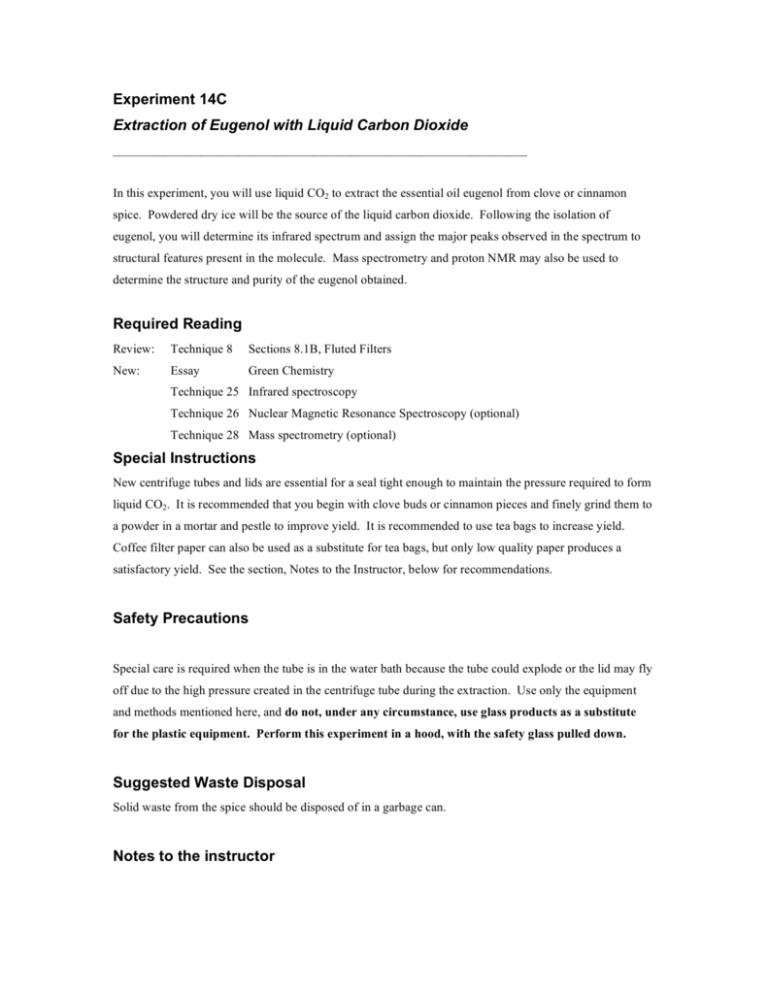
Experiment 14C Extraction of Eugenol with Liquid Carbon Dioxide __________________________________________________________________ In this experiment, you will use liquid CO2 to extract the essential oil eugenol from clove or cinnamon spice. Powdered dry ice will be the source of the liquid carbon dioxide. Following the isolation of eugenol, you will determine its infrared spectrum and assign the major peaks observed in the spectrum to structural features present in the molecule. Mass spectrometry and proton NMR may also be used to determine the structure and purity of the eugenol obtained. Required Reading Review: Technique 8 Sections 8.1B, Fluted Filters New: Essay Green Chemistry Technique 25 Infrared spectroscopy Technique 26 Nuclear Magnetic Resonance Spectroscopy (optional) Technique 28 Mass spectrometry (optional) Special Instructions New centrifuge tubes and lids are essential for a seal tight enough to maintain the pressure required to form liquid CO2. It is recommended that you begin with clove buds or cinnamon pieces and finely grind them to a powder in a mortar and pestle to improve yield. It is recommended to use tea bags to increase yield. Coffee filter paper can also be used as a substitute for tea bags, but only low quality paper produces a satisfactory yield. See the section, Notes to the Instructor, below for recommendations. Safety Precautions Special care is required when the tube is in the water bath because the tube could explode or the lid may fly off due to the high pressure created in the centrifuge tube during the extraction. Use only the equipment and methods mentioned here, and do not, under any circumstance, use glass products as a substitute for the plastic equipment. Perform this experiment in a hood, with the safety glass pulled down. Suggested Waste Disposal Solid waste from the spice should be disposed of in a garbage can. Notes to the instructor Special care needs to be taken if filter paper used in this experiment. It is critical that fast filter paper be employed. Whatman #4 (11 cm) filter paper may be used, but for best results, we recommend cheap basket type coffee filter paper that has been cut to 11 cm in diameter.1 We recommend that you purchase 50-mL plastic centrifuge tubes made of durable polypropylene.2 The centrifuge tubes may be reused for up to 5 times, but then they must be replaced after this time because they will not hold the pressure required for the carbon dioxide to be maintained in the liquid state. Procedure Apparatus. Obtain a 50 mL plastic centrifuge tube and cap. Perform this experiment in a hood, with the safety glass pulled down. Caution: Do not under any circumstance use glass centrifuge tubes as a substitute Coil a 15 cm piece of copper wire twice at one end so that it will fit inside the centrifuge tube. The wire should be long enough so that you will have a “handle” that can be used to lower the spice into the tube and will allow you to easily remove the tea bag after the extraction. The coil prevents the tea bag containing the spice from falling to the bottom of the tube into the extracted oil. Preparing the Spice. Grind up about 2.0 g of clove buds or cinnamon to a very fine powder in a mortar and pestle. Obtain an empty tea bag and weigh it. Adjust the tea bag so that it will fit into the centrifuge tube. Now transfer the powdered cloves or cinnamon to the tea bag, and record the exact weight of spice. 1 Costco sells bulk basket type coffee filters designed for 8-12 cups. This type of filter fits Mr. Coffee machines. The best paper is very thin so that you can see light through the paper. 2 WWR and Fisher supply durable 50-mL centrifuge tubes made of clear polypropylene. Extraction. Fill a 1000 mL plastic graduated cylinder (it’s actually a hydrometer) two-thirds full o with hot tap water (40-45 C) and place it in a hood. Working as quickly as possible, crush some dry ice into a fine powder and place it only in the tapered part of the centrifuge tube at the bottom. Insert the tea bag containing the ground spice into the copper coil and gently push the coil into the tube, sliding it down to the level of the dry ice. You will need to push the tea bag down into the tube with your index finger as you push the copper coil into the tube. Fill the remainder of the tube with the finely crushed dry ice, tapping the bottom of the tube on the counter and adding more dry ice until the tube is full. Then cap the centrifuge tube as tightly as you can make it. All of these operations should be carried out as quickly as possible. Lower the capped centrifuge tube, tapered end first into the graduated cylinder containing warm water in a hood. Pull the hood safety glass down as soon as you place the centrifuge tube into the warm water. There is some danger of a pressure explosion so do not look directly into the open end of the plastic tube. The dry ice should liquefy after a minute and remain in the liquid state for about 9 minutes. If the dry ice has not entered the liquid state after about 2 minutes, it is likely that the centrifuge tube leaked from around the cap and did not have an opportunity to build up sufficient pressure. Gently pour out the water in the plastic tube and unscrew the cap of the centrifuge tube. You should replace the cap and tube, and try again. Also, if you wait too long before sealing the centrifuge tube, this can lead to failure. After about 9 minutes, all the liquid CO2 should have vaporized and the gas will have escaped from around the cap on the centrifuge tube. Take the centrifuge tube out of the graduated cylinder and remove the cap. Lift the filter cone out of the centrifuge tube using the wire handle on the copper coil. Dispose of the waste spice in a trash can. Remove the clove or cinnamon oil from the bottom of the centrifuge tube with a Pasteur pipet and transfer the eugenol oil to a small preweighed sample vial. Reweigh the vial to determine weight of eugenol obtained from the extraction. Calculate the weight percentage recovery of the eugenol from the original weight of spice used. Spectroscopy. Infrared Spectroscopy. Determine the infrared spectrum of the oil as a neat liquid sample. (double salt plate sandwich — Technique 25, Section 25.2). Include the infrared spectrum with your laboratory report, along with an interpretation of the principal peaks. 3 3 Extraction of eugenol with liquid CO2 yields an extra peak at 1764 cm-1 which is attributed to eugenol acetate, a by-product of the extraction; GC-MS will be useful as an optional experiment in identifying the impurity. Nuclear Magnetic Resonance Spectroscopy (optional). At the instructor’s option, determine the proton NMR spectrum of your eugenol. Assign the peaks in the spectrum to the structure of eugenol. Mass spectrometry (optional). At the instructor’s option, determine the mass spectrum of the eugenol sample (Technique 28). Try to assign as many of the fragments in the spectrum as possible. Report Attach your infrared spectra to your report and label the major peaks with the type of bond or group of atoms that is responsible for the absorption. If you have obtained the proton NMR spectrum of your sample, include the spectrum with your report. Be sure to interpret your spectrum fully. If you determined mass spectra, identify the important fragment ion peaks. Also include your weight percentage recovery calculation. Reference McKenzie, Lallie C.; Thompson, John E.; Sullivan, Randy; Hutchison, James E. “Green chemical processing in the teaching laboratory: a convenient liquid CO2 extraction of natural products.” Green Chemistry, 6 (2004), 355-358.

